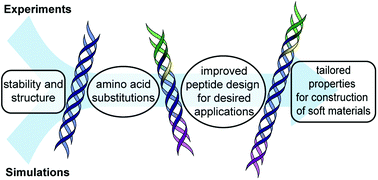Combining simulations and experiments for the molecular engineering of multifunctional collagen mimetic peptide-based materials†
Abstract
Assembling peptides allow the creation of structurally complex materials, where amino acid selection influences resulting properties. We present a synergistic approach of experiments and simulations for examining the influence of natural and non-natural amino acid substitutions via incorporation of charged residues and a reactive handle on the thermal stability and assembly of multifunctional collagen mimetic peptides (CMPs). Experimentally, we observed inclusion of charged residues significantly decreased the melting temperature of CMP triple helices with further destabilization upon inclusion of the reactive handle. Atomistic simulations of a single CMP triple helix in explicit water showed increased residue-level and helical structural fluctuations caused by the inclusion of the reactive handle; however, these atomistic simulations cannot be used to predict changes in CMP melting transition. Coarse-grained (CG) simulations of CMPs at experimentally relevant solution conditions, showed, qualitatively, the same trends as experiments in CMP melting transition temperature with CMP design. These simulations show that when charged residues are included electrostatic repulsions significantly destabilize the CMP triple helix and that an additional inclusion of a reactive handle does not significantly change the melting transition. Based on findings from both experiments and simulations, the sequence design was refined for increased CMP triple helix thermal stability, and the reactive handle was utilized for the incorporation of the assembled CMPs within covalently crosslinked hydrogels. Overall, a unique approach was established for predicting stability of CMP triple helices for various sequences prior to synthesis, providing molecular insights for sequence design towards the creation of bulk nanostructured soft biomaterials.



 Please wait while we load your content...
Please wait while we load your content...